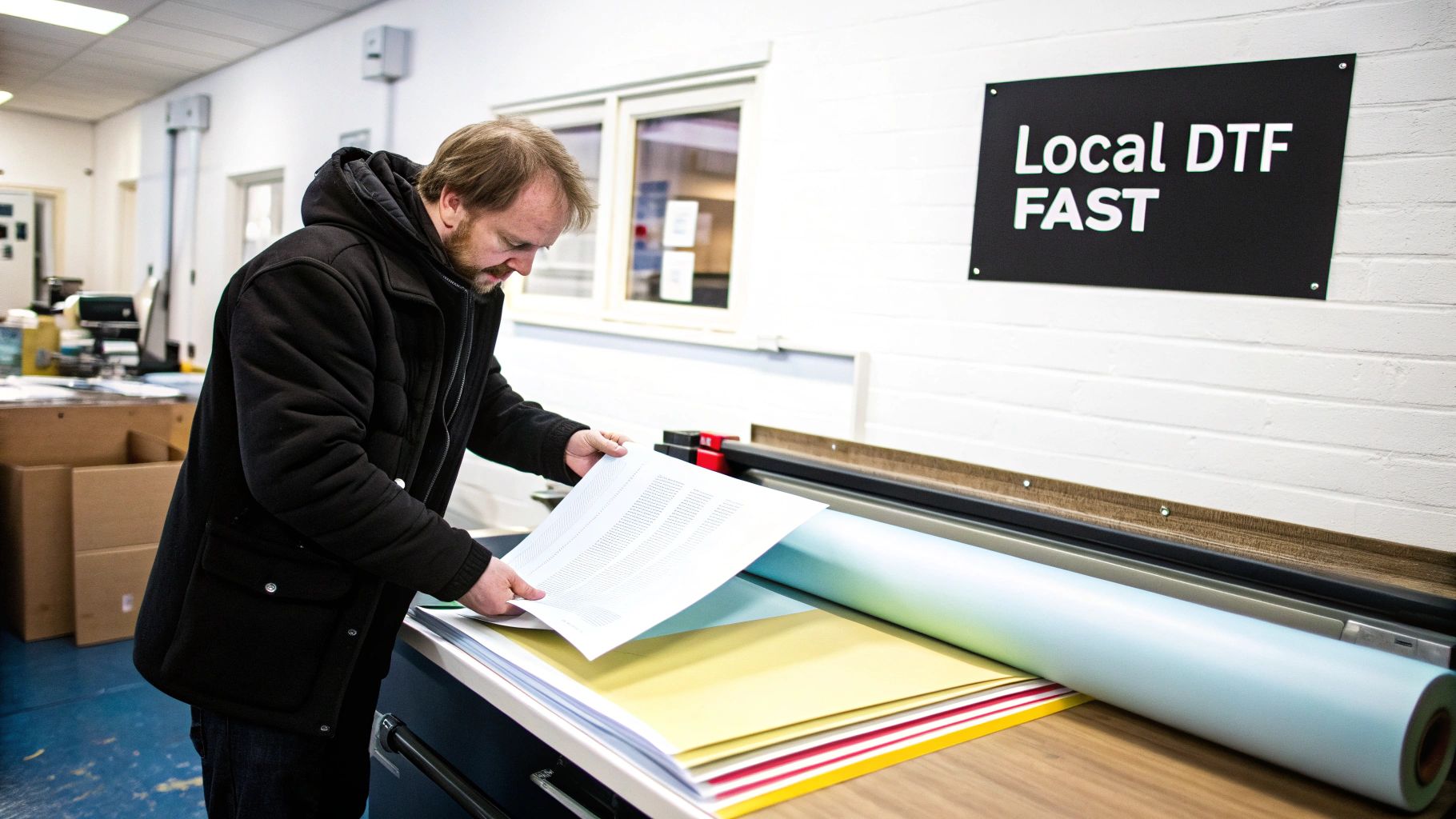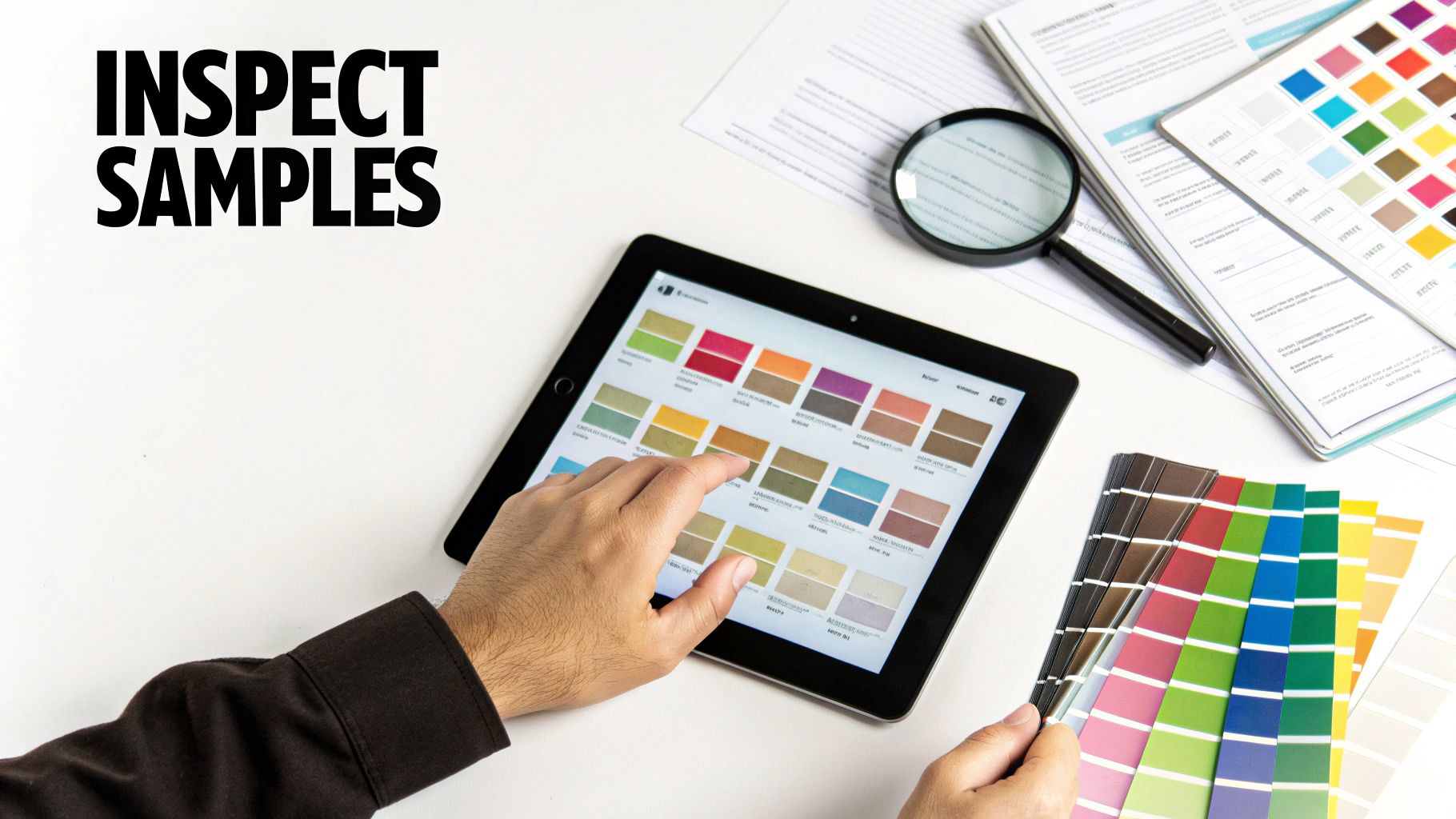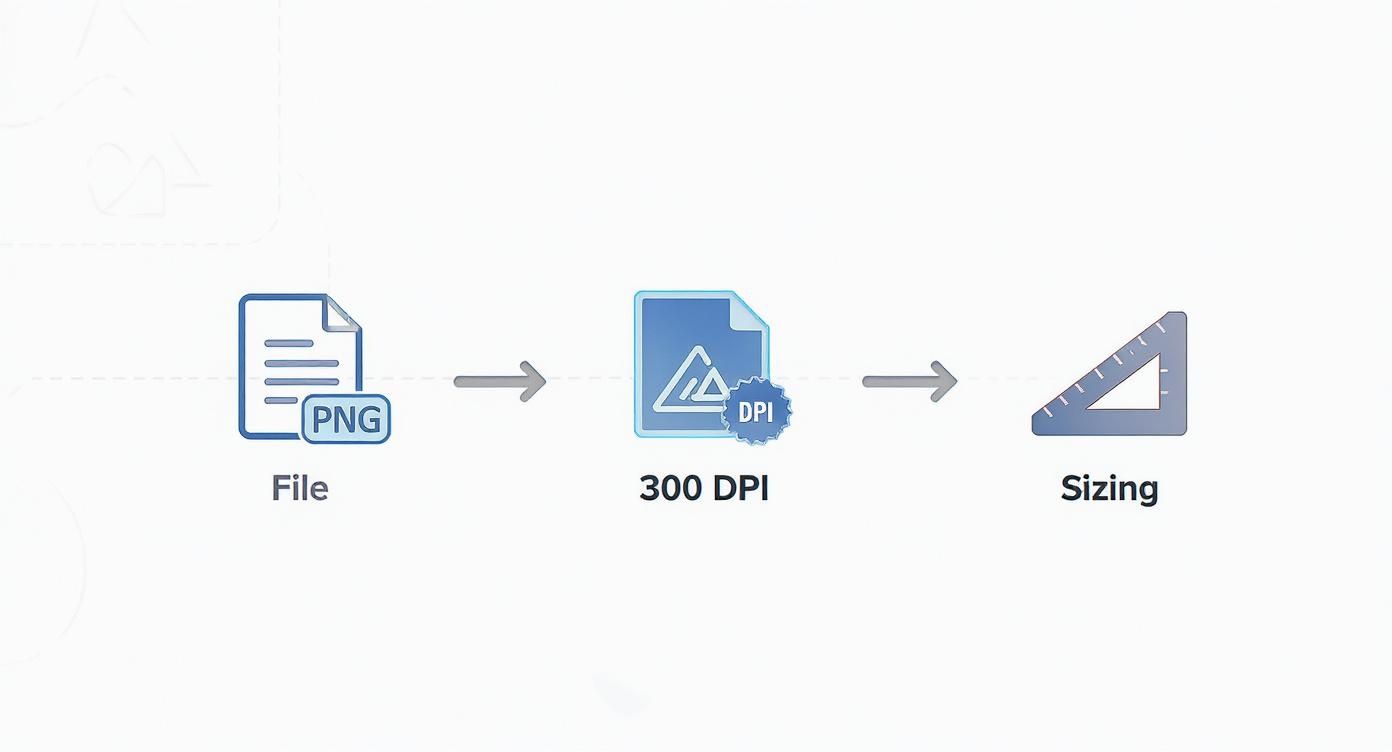
Finding DTF Transfers Near Me Your Ultimate UK Guide
Share
On the hunt for "DTF transfers near me"? Let's cut to the chase: sourcing your transfers from a local UK-based provider is almost always the smartest, fastest, and most cost-effective move you can make for your project. Going local gives you a direct line to your supplier, slashes shipping times, and even lets you physically check the quality before you commit to a big order.
Why Sourcing Local DTF Transfers Is a Game Changer

When you're getting a clothing line off the ground or need custom gear for an event yesterday, speed and quality aren't just nice-to-haves—they're everything. While those huge overseas suppliers might look tempting with their rock-bottom prices, partnering with a local DTF provider gives you some serious advantages that directly impact your bottom line and your peace of mind.
The most obvious win is the massive reduction in turnaround time. Forget waiting weeks for an international shipment to crawl through customs. A local supplier can often have your transfers ready in just a few days. That kind of agility is a lifesaver when you're up against a tight deadline or need to restock a best-selling design fast.
The Power of Proximity
Working with someone nearby isn't just about getting things quicker; it's about having more control. You get to build an actual relationship with the people handling your prints. That personal connection makes communication and sorting out any issues a breeze, turning a simple transaction into a proper partnership.
What's more, being close means you can do tangible quality checks. You can often ask for a sample or even pop into their facility to see and feel the product for yourself. This is your chance to make sure the colours are spot on, the feel is right, and the durability is up to scratch before you sink your money into a full production run. If you're new to this, it's worth taking a moment to learn more about what DTF transfers are and how they work.
By choosing a local partner, you're not just buying a product; you're investing in reliability. You sidestep the risks of lost shipments, unexpected import duties, and communication barriers that can plague overseas orders.
Finally, you’re supporting a local UK business and putting money back into your community's economy. You also get to ditch those hefty international shipping fees and shrink your project's carbon footprint—a win for your budget and the planet. This blend of speed, quality assurance, and real savings makes finding DTF transfers near me a genuinely strategic move for any creator or business.
Local vs National DTF Suppliers At a Glance
Sometimes, seeing the benefits laid out makes the decision even clearer. Here's a quick breakdown of why keeping it local often makes the most sense for your custom apparel projects.
| Benefit | Impact on Your Project |
|---|---|
| Faster Turnaround | Get your transfers in days, not weeks. Perfect for tight deadlines. |
| Lower Shipping Costs | Eliminate expensive international courier and customs fees. |
| Hands-On Quality Control | Opportunity to see and feel samples before placing a large order. |
| Easier Communication | No time zone issues or language barriers. Just direct, clear contact. |
| Support Local Economy | Your investment stays within the UK, supporting local jobs. |
| Reduced Carbon Footprint | Less distance for your goods to travel is better for the environment. |
Ultimately, the ability to build a relationship and have a supplier just down the road offers a level of security and convenience that's hard to beat.
Understanding Why DTF Printing Is So Popular

To really get why everyone is searching for "DTF transfers near me," you need to understand what makes this technology a game-changer. Think of Direct-to-Film (DTF) printing as the perfect hybrid, taking all the best bits from traditional screen printing and modern Direct-to-Garment (DTG) methods.
Screen printing, for example, is brilliant for huge runs, but it gets complicated and expensive for small batches with lots of colours because each colour needs its own screen. DTF blows that limitation out of the water. It handles photorealistic, full-colour designs in one go, which means no minimum orders and complete creative freedom. Your most intricate, colourful logo is just as straightforward to produce as a simple one-colour design.
Then there's DTG, which is fantastic on cotton but often struggles with polyester and other synthetic fabrics. DTF, on the other hand, works beautifully on almost any material you can get under a heat press—cotton, poly, blends, denim, you name it. This incredible versatility is a massive reason for its recent explosion in popularity.
The Secret to Its Success
The magic of DTF lies in its clever but simple process. It starts with a specialised printer laying down a water-based ink design onto a clear film. Crucially, a white ink layer is printed on top of the colours, which acts as a base. This is what makes the final design pop on any colour garment, from black to neon pink.
Once printed, a fine adhesive powder is sprinkled over the wet ink and then melted with heat to cure it. This creates a durable, ready-to-press transfer. When that transfer meets a t-shirt under a heat press, the adhesive activates and permanently bonds the design to the fabric.
The result? A print that’s soft to the touch, stretches with the garment without cracking, and holds up incredibly well in the wash. It’s a premium finish that customers can immediately see and feel.
This mix of quality, flexibility, and efficiency is fuelling some serious market growth. In fact, the UK's DTF printing market is predicted to hit £249.0 million by 2030—a massive indicator of how many businesses and creators are getting on board. This growth is all about the demand for custom gear and the cost-effective nature of the process, making local print shops more accessible than ever. For a deeper dive, check out our comprehensive guide to the DTF printing process.
Key Advantages You Can Expect
So, what does this all mean for your project? When you find a good local DTF supplier, you're tapping into a technology with some very clear benefits:
- Exceptional Detail and Colour: DTF nails intricate details and a full spectrum of vibrant colours, ensuring your design looks exactly how you envisioned it.
- Fabric Freedom: From a standard cotton tee to tricky sportswear, DTF delivers a consistent, high-quality finish across a huge range of materials.
- Impressive Durability: These prints are built to last. They have excellent wash resistance and won't fade or peel easily, giving your products a much longer life.
- Soft and Flexible Feel: Forget those old, stiff transfers that felt like a plastic shield. DTF prints are lightweight and move with the fabric, making them far more comfortable to wear.
Keeping these points in mind will help you have a much better conversation with potential suppliers and truly appreciate the quality they can bring to your project.
Smart Strategies to Find Local DTF Providers
Finding the right local print partner can feel like searching for a needle in a haystack, but a few savvy tactics will help you cut through the noise. Of course, a quick search for "DTF transfers near me" is a decent starting point, but you can get much better results by being a bit more specific.
Think like a local. Instead of a generic search, add your city or even your postcode to the query. For example, "DTF printing Manchester M1" tells Google you're serious about proximity, helping you sidestep national companies that just happen to be good at keyword targeting.
Beyond the Basic Search
Don't just stick to the first page of Google. It's time to dig a little deeper. Check out local business directories like Yell or even your local Chamber of Commerce website. These are goldmines for finding verified businesses right in your community, often complete with customer reviews and contact details.
Another brilliant, and often overlooked, resource is social media. Jump onto Facebook and search for local creative community groups or small business networks. You'd be surprised how many small, independent print shops use these spaces to show off their work and connect directly with customers. You might just stumble upon a hidden gem that pours its budget into quality, not Google Ads.
If you're new to the whole customisation game, it helps to understand how different printing methods stack up. You can learn a lot more about custom t-shirt printing options near you to see why DTF might be the perfect fit for your project.
Evaluating Your Online Findings
Okay, so you've got a shortlist. Now it's time to do some digital detective work and scrutinise their online presence. A professional, easy-to-navigate website is usually a great sign.
Here’s what to look for to tell the pros from the amateurs:
- Clear Service Pages: They should have a dedicated page explaining their DTF transfer services. Do they mention the fabrics they work with or give you an idea of turnaround times? The more detail, the better.
- A Solid Portfolio: A gallery of past projects is a must. This is your chance to see the real-world quality of their work. Look at the colour vibrancy, the crispness of the lines, and the sharpness of any fine text.
- Transparent Contact Info: Is their physical address listed? Do they have a proper phone number and a professional email address? If they're hiding this basic information, it can be a red flag.
- Genuine Customer Reviews: Check for reviews on independent platforms like Google Maps or Trustpilot, not just the glowing testimonials on their own site. You're looking for consistent feedback on quality, communication, and reliability.
A quick tip: the businesses you see at the top of search results are often the ones who have really nailed their online marketing. Understanding the basics of local SEO strategies for small businesses can give you some insight into why certain printers appear first and help you spot well-run, professional outfits.
Local vs. National Suppliers: A Final Thought
While big national online-only services might tempt you with low prices, they simply can't compete with the advantages of a genuine local partner.
Working with a local supplier means faster turnarounds, zero shipping delays, and the priceless opportunity to see, touch, and approve a physical sample before committing to a full run. That hands-on quality control is something you just can't get from a company hundreds of miles away. By using these smarter search strategies, you’re not just finding a supplier; you’re finding a reliable partner for your creative projects.
How to Vet Your Shortlist of DTF Suppliers

You’ve done the digital legwork and have a list of potential local printers. Brilliant. Now for the most important bit: figuring out which one is the right partner for you. Moving from just a name on a screen to a collaborator you can truly rely on means asking the right questions and knowing what to look for.
The goal here isn't just about finding the cheapest price tag. It's about finding a supplier who delivers consistent quality, turning them into a dependable part of your production line. A genuinely great local provider for DTF transfers near me will be transparent, quick to respond, and actually invested in helping you succeed.
Making First Contact and Asking the Right Questions
That first email or phone call is much more than a price check—it’s your first real test of their customer service. A prompt, helpful, and professional reply is a massive green flag. Before you even get in touch, have a checklist of essential questions ready to go.
Here are the non-negotiables you should be asking about:
- Their Gear and Inks: You don't need to be a tech wizard, but asking what kind of printers and inks they use shows you're serious about quality. Any reputable supplier will be proud of their setup and happy to share the details.
- Turnaround Times: Be specific. Ask what their standard production time is for an order of your typical size. This is crucial for managing your own deadlines and customer expectations.
- Minimum Order Quantity (MOQ): This is a huge one. Many modern DTF suppliers now have no MOQ, which is a game-changer for small brands or one-off test runs. Confirming this upfront avoids any nasty surprises later.
- Artwork Requirements: What file formats do they prefer? What resolution do they need? A clear, simple artwork submission process is the hallmark of an organised and professional operation. You can get a better feel for the equipment involved by checking out our guide to choosing a t-shirt transfer printer.
Putting Quality to the Test
Talk is one thing, but the proof is always in the print. Never, ever commit to a large order without seeing the quality for yourself first. The absolute best way to do this is by getting your hands on a sample pack.
When that sample arrives, put it through its paces. Don't just look at it—feel it. A quality DTF transfer should have a soft, flexible feel, not a thick, plastic-like texture that sits heavily on the fabric. Check the colours against your original digital design; they should be vibrant, rich, and accurate.
The real test is the stretch test. Gently pull the fabric where the transfer has been applied. A good DTF print will stretch right along with the material without cracking, peeling, or fading. This is the single most critical indicator of its long-term durability.
Reading Between the Lines
Finally, look beyond what the supplier tells you about themselves. Dig into their Google reviews and social media comments. Are you seeing patterns in the feedback? Are customers consistently raving about their quality, speed, or communication?
The boom in UK e-commerce has massively fuelled the demand for local, on-demand printing, making it easier than ever for customers to order custom apparel online. This trend is a key reason why searches for local printers have shot up, with businesses increasingly offering low or no minimums to meet this new demand.
A supplier's portfolio and social media presence also tell a story. Do they showcase a variety of complex, colourful designs on their feed? Are they actively engaging with their community and answering questions? A passionate, professional, and proven supplier is precisely the partner you need to bring your creative vision to life.
Preparing Your Artwork for a Flawless Print
Submitting a poorly prepared design file to a printer is a bit like giving a chef the wrong ingredients; the final dish is never going to be what you pictured. To get that crisp, vibrant DTF transfer you’re after, a little bit of artwork prep goes a very, very long way.
Getting this right from the start avoids frustrating delays and means your supplier can get your order into production without any fuss. The good news is the requirements are straightforward. Once you know them, they become second nature for every project you do. The goal is simple: provide a file that’s 100% print-ready, removing any guesswork for the production team.
Nailing the Technical Specifications
The first rule of DTF printing is resolution. It’s non-negotiable. For a sharp, professional-looking print that doesn't look like it was made in someone's garage, your artwork must be at least 300 DPI (dots per inch). If you submit a low-resolution file, like an image you’ve nabbed from a website, you'll end up with a blurry, pixelated transfer. It just looks amateur. Always start your design in a high-resolution canvas from the very beginning.
Next up is the file format. The absolute gold standard for DTF is a PNG file with a transparent background. This is critical. A transparent background ensures that only your actual design gets printed, not a big, ugly white box around it. Other formats, like JPEGs, can't handle transparency and will always have a solid background, making them completely unsuitable for this process.
By mastering these two simple rules—300 DPI resolution and a transparent PNG format—you’ll eliminate over 90% of the common artwork issues that cause production delays and subpar results.
Your Pre-Submission Checklist
Before you hit 'send' on that email to your chosen local supplier, run through this quick mental checklist. It only takes a minute but can save you hours of back-and-forth emails trying to sort things out.
- Is the background truly transparent? Pop the file open in an editor one last time to confirm there's no sneaky white or coloured background hiding there.
- Is the resolution set to 300 DPI? This ensures every fine line and tiny detail in your design will come out looking crisp and clear.
- Have you checked for stray pixels? Zoom right in on your design and hunt for any tiny, unwanted dots or marks around the edges. Trust me, they will get printed!
- Are your colours correct? Most printers work in a CMYK colour profile, but submitting an RGB file is usually fine as their software handles the conversion. Just be aware that slight colour shifts can happen in the process.
Taking the time to prepare your files correctly is one of the most important parts of creating fantastic personalised t-shirt printing projects.
When you’re finally ready to place your order, be crystal clear about the exact size you want the transfer to be, usually in inches or centimetres. Your supplier will use this info to create a digital proof—basically a mock-up showing how your design will look. Always, always review this proof carefully. It’s your final chance to catch any mistakes before the printing begins and your vision becomes a reality.
Finding Your Perfect Local DTF Partner
Right then, you should now be feeling much more confident about finding a fantastic local supplier for your DTF transfers. Choosing a UK-based partner really does make a world of difference—you get faster turnarounds, you can keep a closer eye on quality, and you’re supporting a local business. From smarter searching to doing your homework on potential printers, you’ve got a clear path forward.
Now you can go out and find a supplier who really gets what you’re trying to achieve. One of the biggest hurdles, though, is making sure your artwork is spot on. Get this wrong, and even the best printer will struggle.
This visual guide breaks down the essential steps for preparing your artwork to ensure a flawless print every single time.

This flow chart highlights the absolute must-haves for professional DTF printing: the correct file type, the right resolution, and precise sizing. I've seen countless projects delayed or ruined by simple mistakes in these areas. By mastering these simple but crucial steps, you sidestep the most common causes of printing headaches.
You’re now fully equipped to turn your creative ideas into professionally printed garments. Your ideal local printing partner is out there, ready to help you bring your designs to life with stunning quality. All that's left is for you to take that final step.
Your Top Questions About Local DTF Transfers, Answered
When you start searching for "DTF transfers near me," you'll probably find a few questions pop up again and again. Getting these sorted from the outset gives you the confidence to pick the right local printer and get your order in without any guesswork.
Price is almost always the first thing on people's minds. The cost of a transfer really depends on its size, how many you're ordering, and how intricate your design is. It can be helpful to understand how local custom decoration services approach pricing for similar services, like embroidery, to get a feel for what to expect.
Another big one is durability. How do these things actually hold up after a few spins in the washing machine? You'll be glad to know that a professionally printed and applied DTF transfer is incredibly tough. It can easily handle 50+ washes without cracking, peeling, or fading away, making it a solid choice for everything from daily wear to heavy-duty work gear.
What Else Do People Typically Ask?
Let's dive into a few more common queries. Getting these answers straight will help you have a much more productive chat with any potential supplier.
- What fabrics can I use? This is where DTF really shines. It works beautifully on cotton, polyester, poly-cotton blends, denim—even some leathers. That incredible versatility is one of the main reasons it's become so popular.
- Should I buy the transfers or a finished shirt? It all comes down to what gear you have. If you own a heat press, just ordering the transfers is a great way to go. If not, most local printers will offer a complete service, sourcing the garment and pressing the design for you.
- How long will it take? With a UK-based provider, you can generally expect your transfers to arrive within 2-5 working days. That's a world away from the weeks you might be left waiting for an international shipment.
One thing you’ll definitely want to get clear on is the difference between a "gang sheet" and ordering individual transfers. A gang sheet lets you cram multiple designs onto a single large film. It’s a brilliant way to cut down on waste and lower your cost per print, especially if you have a lot of smaller logos or neck tags.
At the end of the day, any good local supplier will be more than happy to walk you through all of this. Their transparency and willingness to help is usually the best sign that you've found a partner who genuinely cares about getting your project right. Never be afraid to ask questions—it's the surest way to get exactly what you need.
Ready to bring your designs to life with vibrant, durable prints? Psyque offers premium DTF transfers and custom apparel right here in the UK. Explore our collections or get in touch for your bespoke project at https://psyque.co.uk.
